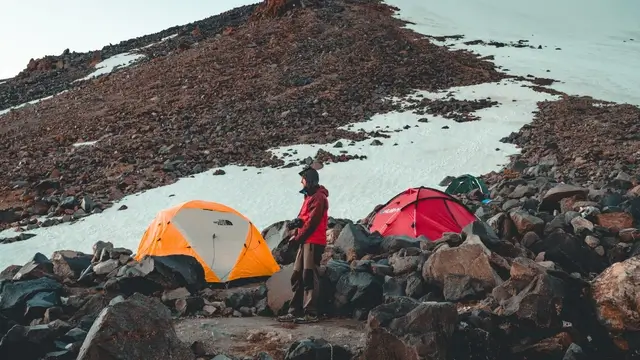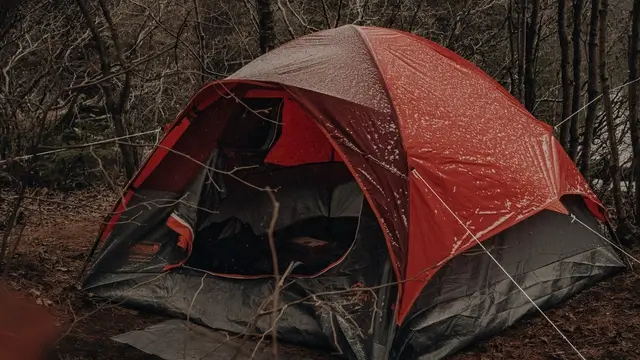How to Secure a Tent Without Stakes
Embarking on a camping adventure requires quick thinking and adaptation. There may be instances where the usual supplies, like tent stakes, are unavailable.
Perhaps you’ve forgotten to pack them or the campsite ground is too hard. Maybe the weather has turned and stakes just aren’t enough. Whatever the reason, knowing how to secure a tent without stakes is a valuable skill.
Yet, it’s not without challenges. Tent anchoring for optimal stability without stakes can be tricky. The absence of stakes might mean wrestling with a flapping tent in a gust of wind. But with a little ingenuity and the correct techniques, you can overcome these hurdles.
5 Methods to Secure a Tent without Stakes
When tent stakes aren’t an option, it’s crucial to explore other tent anchoring methods. Using nature and your surroundings can provide effective alternatives to tent stakes, ensuring your shelter’s stability.
1. Using Rocks

Anchoring your tent with rocks is a tried-and-true method when traditional tent stakes aren’t practical, such as in hard ground or in windy conditions. The robust weight and stability of rocks make them an excellent substitute for stakes.
To adopt this approach, you need to pick rocks that are heavy enough to anchor your tent securely, but not so large as to risk harm to your tent material.
The chosen rocks for tent anchoring should be strategically placed around the tent’s corners and edges.
This placement maximizes stability and forms a stout shield against any wind that may threaten to displace your tent.
In this way, the use of rocks for tent anchoring can provide a dependable solution in challenging camping situations.
2. Utilizing Logs for Tent Anchoring
Logs, generously bestowed by nature, can be innovatively repurposed to secure your tent. Why are they an ideal choice?
Their substantial size and weight make them sturdy enough to resist forceful gusts of wind, which is a common challenge when camping.
To effectively use logs for this purpose, position them around the perimeter of your tent.
This strategic placement creates a solid boundary that keeps your tent grounded and secure against the wind.
3. Tent Securing with Sandbags
Securing a tent on a beach can present unique challenges, such as loose, shifting sand that can render traditional tent stakes ineffective.
This is where the use of sandbags comes into play. They offer an effective and practical solution for anchoring your tent securely in beach conditions.
Sandbags, in essence, are sturdy bags that can be filled with sand and used as weights to secure your tent. The process of utilizing sandbags to their full potential is relatively straightforward:
- Procure or Prepare Sandbags: Sandbags are a crucial component of this method. You can either purchase them pre-made or bring along sturdy bags to fill with sand once you reach your campsite.
- Fill the Sandbags with Sand: Once you’ve obtained your sandbags, the next step is to fill them with sand. You can easily do this by utilizing the ample sand at your beach campsite.
- Position Filled Sandbags Along Tent Edges: After filling your sandbags, position them strategically along the edges of your tent. The placement of these sandbags is essential for optimal tent stability.
- Ensure Sandbags Are Stable: Check the stability of each sandbag. You want to ensure that they are heavy enough to resist the wind, but not so heavy as to strain your tent material.
The significant weight of the sand-filled bags will ensure your tent stays secure, providing much-needed stability even in windy conditions.
In essence, sandbags allow you to enjoy a secure beach camping experience, even without the assistance of traditional tent stakes.
So, the next time you’re planning a beach camping trip, consider including sandbags in your camping kit. They could be the key to a stress-free and enjoyable beach camping adventure.
4. Tent Securing with Rope and Tarp Clips
If your camping area is abundant with trees, ropes and tarp clips can be your solution for securing a tent without stakes.
This method comes in handy when traditional tent stakes aren’t available or ineffective, and you are in a location that’s rich in sturdy trees.
The process is rather simple yet effective. Begin by tying one end of a rope to a reliable tree. This tree is now acting as your stake, providing the stability you need. Now, attach tarp clips to the other end of the rope, securing it to the tent.
This technique creates a strong seal that tightly secures your tent to the landscape, ensuring it maintains its position even in windy conditions.
It’s a testament to the resourcefulness and adaptability that are key to a successful camping adventure, using the environment around you when traditional options are not feasible.
5. Bungee Cords and Clothesline Rope

Bungee cords and clothesline rope represent an adaptable and effective solution for securing your tent without stakes.
Renowned for their versatility, these materials can be expertly used to establish a firm hold for your tent when traditional methods fall short.
The purpose of utilizing bungee cords and clothesline rope is simple: they provide a reliable anchor for your tent, ensuring it remains stable even under challenging conditions.
Whether you’re lacking stakes or dealing with a sudden gust of wind, these tools offer a flexible alternative that can counterbalance the forces of nature.
Applying this method is straightforward:
- Start by threading the bungee cords or clothesline rope through the corner loops of your tent.
- Secure the other end of the cord or rope to a sturdy and static object nearby, such as a robust tree branch.
- It’s crucial to ensure that the object you’ve chosen can withstand the weight and tension of the tent. This object will be providing the stability required to keep the tent in place. Read about How to Keep Tent Carpet in Place.
Through this approach, bungee cords and clothesline rope can be the key to a secure camping experience, demonstrating that even without stakes, there are effective ways to anchor your tent and enjoy your outdoor adventure.
The Importance and Technique of Tensioning Tent Guylines
Guylines, the cords or ropes extending from your tent to the securing points, are one of the most critical aspects of maintaining your tent’s stability and structure.
They ensure that your tent stands strong against the wind and doesn’t collapse with movements from within or due to weather conditions.
This stability provided by the guylines is not just for the comfort of your sleep; it also significantly contributes to your safety during camping.
Additionally, by preventing the tent walls from touching the occupants, the guylines help to avoid condensation build-up inside the tent.
To effectively tension your guylines:
- Identify your tent guylines, the cords or ropes that extend from your tent to the securing points.
- Pull each guyline outwards from the tent at an angle of approximately 45 degrees. This angle offers the best distribution of force and helps your tent maintain its shape against wind.
- Continue pulling the guylines until they are taut but not overstretched.
- Secure the guylines using the most suitable method available. This could involve using rocks, logs, or sandbags as weights.
- Check the tension and adjust as necessary to ensure your tent is stable and the guylines are not overly strained.
Remember, the tension needs careful adjustment to ensure that your tent is not only stable but also that the guylines aren’t overstretched. Armed with this technique, you’re ready to make your camping experience safer and more comfortable, even without traditional tent stakes.
Considerations Based on Terrain and Weather Conditions
The environment plays a significant role in how you secure your tent. Different terrains may require different methods.
For instance, a rocky campsite might not suit sandbags, but it’s perfect for using larger rocks. On the other hand, a beach campsite offers ample sand for sandbag use.
Weather conditions also affect your choice. A calm day allows for more flexible setups, whereas a windy day demands sturdy securing methods. It’s crucial to adapt your techniques to suit these conditions for optimal tent security.
Read more about: 11 Tips for Camping in Windy Conditions
Safety Precautions
Tent securing without stakes involves novel methods that deviate from traditional camping guidelines and therefore requires special attention to safety. Here are some precautions you should take:
- Item Stability: Use flat-based and stable rocks, logs, or sandbags. Avoid teetering items.
- Secure Fastening: Ensure ropes and cords are tightly knotted and secure.
- Weather Vigilance: Monitor weather and adjust tent securing methods accordingly.
- Safe Handling: Lift heavy items with your knees, not your back. If too heavy, opt for a different method.
- Tripping Hazard Reduction: Place ropes or cords mindfully to prevent tripping. Mark them if possible.
- Surroundings Check: Avoid pitching your tent under loose branches or rocky overhangs.
- Regular Inspection: Regularly inspect your tent’s setup and adjust if necessary.
- Emergency Preparedness: Have a backup plan in case your tent setup fails.
Final Thoughts
Securing a tent without stakes may seem daunting, but it’s entirely achievable with the right resources and techniques. Whether you’re using rocks, logs, sandbags, or ropes, each method offers unique advantages for a secure and safe camping experience.
We encourage you to try these techniques on your next camping trip and share your experiences. Happy camping, and remember, adaptability is the key to a successful adventure!
While this article has equipped you with knowledge, it’s always good to practice these techniques at home before setting out into the wild. By doing so, you’ll ensure that your camping adventure is stress-free and enjoyable.
We hope you’ve found this guide useful. If you have any other tips or tricks on how to secure a tent without stakes, we’d love to hear from you in the comments.